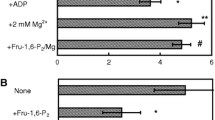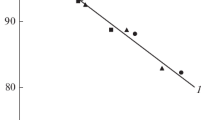Abstract
The oxidized form of vitamin C (dehydroascorbic acid, DHA) completely and irreversibly inactivates recombinant human hexokinase type I, in a pseudo-first order fashion. The inactivation reaction occurs without saturation, indicating that DHA does not form a reversible complex with hexokinase. Further characterization of this response revealed that the inactivation does not require oxygen and that dithiothreitol, while able to prevent the DHA-mediated loss of enzyme activity, failed to restore the activity of the DHA-inhibited enzyme. Inactivation was not associated with cleavage of the peptide chain or cross-linking. The decay in enzymatic activity was however both dependent on deprotonation of a residue with an alkaline pKa and associated with covalent binding of DHA to the protein. In addition, inactivation of hexokinase decreased or increased, respectively, in the presence of the substrates glucose or MgATP. Finally, amino acid analysis of the DHA-modified hexokinase revealed a decrease of cysteine residues.
Taken together, the above results are consistent with the possibility that covalent binding of the reagent with a thiol group of cysteine is a critical event for the DHA-mediated loss of hexokinase activity.
Similar content being viewed by others
References
Fiorani M, De Sanctis R, Saltarelli R, Stocchi V: Hexokinase inactivation induced by ascorbic acid/Fe(II) in rabbit erythrocytes is independent of glutathione-reductive processes and appears to be mediated by dehydroascorbic acid. Arch Biochem Biophys 342: 191-196, 1997
Fiorani M, De Sanctis R, Scarlatti F, Stocchi V: Substrates of hexokinase, glucose-6-phosphate dehydrogenase, and glyceraldehyde-3-phosphate dehydrogenase prevent the inhibitory response induced by ascorbic acid/iron and dehydroascorbic acid in rabbit erythrocytes. Arch Biochem Biophys 356: 159-166, 1998
Stocchi V, Biagiarelli B, Fiorani M, Palma F, Piccoli G, Cucchiarini L, Dachà M: Inactivation of rabbit blood cell hexokinase activity promoted in vitro by an oxygen-radical-generating system. Arch Biochem Biophys 311: 160-167, 1994
Stocchi V, Fiorani M, Biagiarelli B, Piccoli G, Saltarelli R, Palma F, Cucchiarini L, Dachà M: Mitochondria-bound hexokinase from rabbit reticulocytes is resistant to the inactivation induced by Fe(II)/ascorbate. Biochem Mol Biol Int 35: 1133-1142, 1995
Fiorani M, Saltarelli R, De Sanctis R, Palma F, Ceccaroli P, Stocchi V: Role of dehydroascorbate in rabbit erythrocyte hexokinase inactivation induced by ascorbic acid. Arch Biochem Biophys 334: 357-361, 1996
Davies KJ, Goldberg AL: Oxygen radicals stimulate intracellular proteolysis and lipid peroxidation by independent mechanisms in erythrocytes. J Biol Chem 262: 8220-8226, 1987
Levine RL: Oxidative modification of glutamine synthetase. II. Characterization of the ascorbate model system. J Biol Chem 258: 11828-11833, 1983
Winterbourn CC: Comparison of superoxide with other reducing agents in the biological production of hydroxyl radicals. Biochem J 182: 625-628, 1979
Davies KJA: Intracellular proteolytic systems may function as secondary antioxidant defenses: An hypothesis. Free Rad Biol Med 2: 155-173, 1986
Amici A, Levine RL, Tsai L, Stadtman ER: Conversion of amino acid residues in proteins and amino acid homopolymers to carbonyl derivatives by metal-catalyzed oxidation reactions. J Biol Chem 264: 3341-3346, 1989
Minetti M, Forte T, Soriani M, Quaresima V, Menditto A, Ferrrari M: Iron-induced ascorbate oxidation in plasma as monitored by ascorbate free radical formation. No spin-trapping evidence for the hydroxyl radical in iron overloaded plasma. Biochem J 282: 459-465, 1992
Lockwood TD: Inactivation of intracellular proteolysis and cathepsin B enzyme activity by dehydroascorbic acid and reactivation by dithiotreitol in perfused rat heart. Biochem Pharmacol 54: 669-675, 1997
Bianchi J, Rose RC: Dehydroascorbic acid and cell membranes: Possible disruptive effects. Toxicology 40: 75-82, 1986
Dunn JA, Ahmed MU, Murtiashaw MH, Richardson JM, Walla MD, Thorpe SR, Baynes JW: Reaction of ascorbate with lysine and protein under autoxidizing conditions: formation of N-epsilon-(carboxymethyl) lysine by reaction between lysine and products of autoxidation of ascorbate. Biochemistry 29: 10964-10970, 1990
Bianchi M, Serafini G, Bartolucci E, Giammarini C, Magnani M: Enzymatic properties of overexpressed human hexokinase fragments. Mol Cell Biochem 189: 185-193, 1998
Sabini E, Rosano C, Capasso C, Rizzi M, Bolognesi M, Bianchi M, Serafini G, Bartolucci E, Magnani M: Expression, purification and preliminary crystallographic studies of human hexokinase I. Prot Pep Lett 5: 237-242, 1998
Washko PW, Wang Y, Levine M: Ascorbic acid recycling in human neutrophils. J Biol Chem 268: 15531-15535, 1993
Beutler E: Red Blood Cell Metabolism: A Manual of Biochemical Methods. Grune and Stratton, New York, 1984
Stocchi V, Piccoli G, Magnani M, Palma F, Biagiarelli B, Cucchiarini L: Reversed-phase high-performance liquid chromatography separation of dimethylaminoazobenzene sulfonyl-and dimethylaminoazobenzene thiohydantoin-amino acid derivatives for amino acid analysis and microsequencing studies at the picomole level. Anal Biochem 178: 107-117, 1989
Stocchi V, Cucchiarini L, Piccoli G, Magnani M: Complete highperformance liquid chromatographic separation of 4-N,N-dimethylaminoazobenzene-4′-thiohydantoin and 4-dimethylaminoazobenzene-4′-sulphonyl chloride amino acids utilizing the same reversedphase column at room temperature. J Chromatogr 349: 77-82, 1985
Vallorani L, Palma F, De Bellis R, Piccoli G, Sacconi C, Cucchiarini L, Stocchi V: Reversed-phase high-performance liquid chromatographic amino acid analysis of phosphoproteins electroblotted onto a polyvinylidene difluoride membrane using dimethylaminoazobenzene sulphonyl chloride as derivatizing reagent. Anal Biochem 258: 376-379, 1998
Levine RL: Oxidative modification of glutamine synthetase. I. Inactivation is due to loss of one histidine residue. J Biol Chem 258: 11823-11827, 1983
Schirch DM, Wilson JE: Rat brain hexokinase: Location of the substrate hexose binding site in a structural domain at the C-terminus of the enzyme. Arch Biochem Biophys 254: 385-396, 1987
Laemmli UK: Cleavage of structural proteins during the assembly of the head of bacteriophage T-4. Nature 227: 680-685, 1970
De Bellis R, Agostini D, Piccoli G, Vallorani L, Potenza L, Polidori E, Sisti D, Amoresano A, Pucci P, Arpaia G, Macino G, Balestrini R, Bonfante P, Stocchi V: The tbf-1 gene from the white truffle Tuber borchii codes for a structural cell wall protein specifically expressed in fruitbody. Fungal Genet Biol 25: 87-99, 1998
Bradford MM: A rapid and sensitive method for a quantitation of microgram quantities of protein utilizing the principle of protein-dye binding. Anal Biochem 72: 248-254, 1976
Kitz R, Wilson IB: Esters of methanesulfonic acid as irreversible inhibitors of acetylcholinesterase. J Biol Chem 237: 3245-3249, 1962
Huntny J, Wilson JE: Effect of ligand-induced conformational changes on the reactivity of specific sulfhydryl residues in rat brain hexokinase. Arch Biochem Biophys 283: 173-183, 1990
Jung CH, Wells WW: Spontaneous conversion of L-dehydroascorbic acid to L-ascorbic acid and L-erythroascorbic acid. Arch Biochem Biophys 355: 9-14, 1998
Chou AC, Wilson JE: Rat brain hexokinase: Glucose and glucose-6-phosphate binding sites and C-terminal amino acid of the purified enzyme. Arch Biochem Biophys 163: 191-199, 1974
Swarup G, Kenkare UW: Reaction of brain hexokinase with substratelike reagent. Alkylation of single thiol at the active site. Biochemistry 19: 4058-4064, 1980
Murakami K, Piomelli S: Decay of mammalian hexokinase: Characterization of the specific proteolytic activity. Biochem Biophys Acta 1080: 83-87, 1991
Zeng C, Fromm HJ: Active site residues of human brain hexokinase as studied by site-specific mutagenesis. J Biol Chem 270: 10509-10513, 1995
White TK, Wilson JE: Binding of nucleoside triphosphates, inorganic phosphate, and other polyanionic ligands to the N-terminal region of rat brain hexokinase: Relationship to regulation of hexokinase activity by antagonistic interactions between glucose-6-phosphate and inorganic phosphate. Arch Biochem Biophys 277: 26-34, 1990
Chatterjee IB, Banerjee A: Estimation of dehydroascorbic acid in blood of diabetic patients. Anal Biochem 98: 368-374, 1979
Som S, Basu S, Mukherjee D, Deb S, Choudhury PR, Mukherjee S, Chatterjee IB: Ascorbic acid metabolism in diabetes mellitus. Metabolism 30: 572-577, 1981
Lunec J, Blake DR: The determination of dehydroascorbic acid and ascorbic acid in the serum and synovial fluid of patients with rheumatoid arthritis (RA). Free Rad Res Commun 1: 31-39, 1985
Vera JC, Rivas CI, Golde DW: Resolution of the facilitated transport of dehydroascorbic acid from its intracellular accumulation as ascorbic acid. J Biol Chem 270: 23706-23712, 1995
Welch RW, Wang Y, Crossmann A, Park JB, Kirk KL, Levine M: Accumulation of vitamin C (ascorbate) and its oxidized metabolite dehydroascorbic acid occurs by separate mechanisms. J Biol Chem 270: 12584-12592, 1995
Agus DB, Gambhir SS, Pardridge WM, Spielholz C, Baselga J, Vera JC, Golde DW: Vitamin C crosses the blood-brain barrier in the oxidized form through the glucose transporters. J Clin Invest 100: 2842-2848, 1997
Banhegyi G, Marcolongo P, Puskás F, Fulceri R, Mandl J, Benedetti A: Dehydroascorbate and ascorbate transport in rat liver microsomal vesicles. J Biol Chem 273: 2758-2762, 1998
Mehlhorn RJ: Ascorbate-and dehydroascorbic acid-mediated reduction of free radicals in the human erythrocyte. J Biol Chem 266: 2724-2731, 1991
Hornig D, Weiser H, Weber F, Wiss O: Studies on the uptake of (I-14C)-ascorbic acid and (I-14C)-dehydroascorbic acid by platelets of guinea pigs. Clin Chim Acta 32: 33-39, 1971
May JM, Qu ZC, Whitesell RR, Cobb CE: Ascorbate recycling in human erythrocytes: Role of GSH in reducing dehydroascorbate. Free Rad Biol Med 20: 543-551, 1996
Wells WW, Xu DP: Dehydroascorbate reduction. J Bioeng Biomembr 26: 369-377, 1994
Winkler BS: Unequivocal evidence in support of the nonenzymatic redox coupling between glutathione/glutathione disulfide and ascorbic acid/dehydroascorbic acid. Biochem Biophys Acta 1117: 287-290, 1992
Stadtman ER, Oliver CN: Metal-catalyzed oxidation of proteins. Physiological consequences. J Biol Chem 266: 2005-2008, 1991
Oliver CN, Ahn B, Moerman EJ, Goldstein S, Stadtman ER: Agerelated changes in oxidized proteins. J Biol Chem 262: 5488-5491, 1987
Fornaini G, Leoncini G, Segni P, Calabria GA, Dachà M: Relationship between age and properties of human and rabbit erythrocyte glucose-6-phosphate dehydrogenase. Eur J Biochem 7: 214-222, 1969
Stocchi V, Magnani M, Canestrari F, Dachà M, Fornaini G: Rabbit red blood cell hexokinase. Evidence for two distinct forms, and their purification and characterization from reticulocytes. J Biol Chem 256: 7856-7862, 1981
Goto S, Nakamura A: Age-associated, oxidatively modified proteins: A critical evaluation. Age 20: 81-89, 1997
Stadtman ER: Protein oxidation and aging. Science 257: 1220-1224, 1992
Deutsch JC: Ascorbic acid oxidation by hydrogen peroxide. Anal Biochem 255: 1-7, 1998
Author information
Authors and Affiliations
Rights and permissions
About this article
Cite this article
Fiorani, M., De Sanctis, R., Scarlatti, F. et al. Dehydroascorbic acid irreversibly inhibits hexokinase activity. Mol Cell Biochem 209, 145–153 (2000). https://doi.org/10.1023/A:1007168032289
Issue Date:
DOI: https://doi.org/10.1023/A:1007168032289




